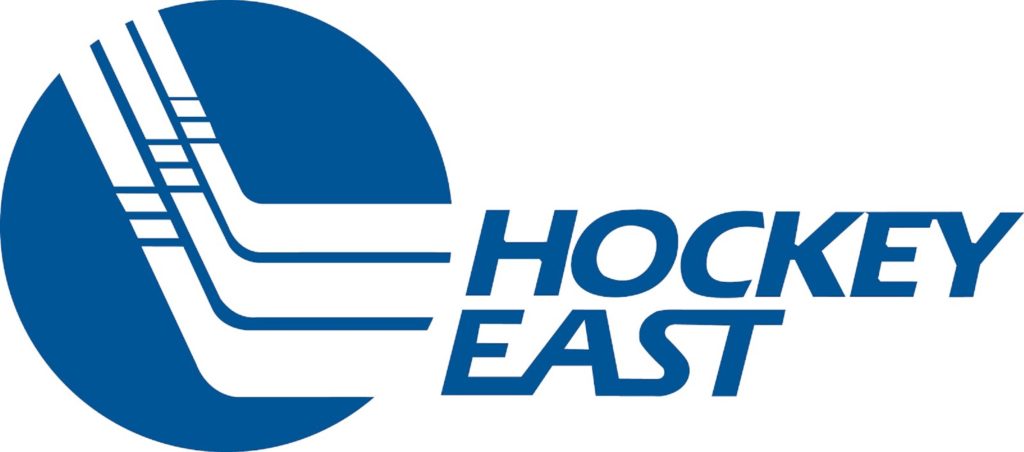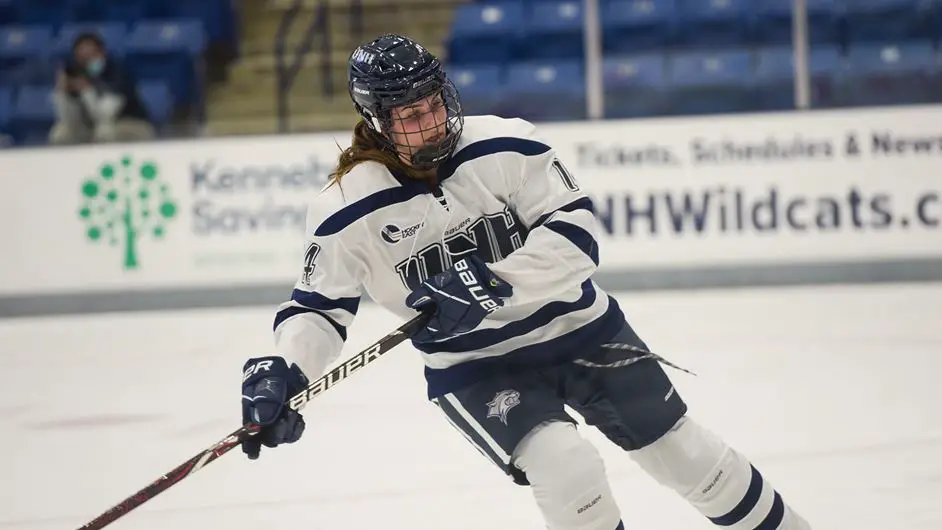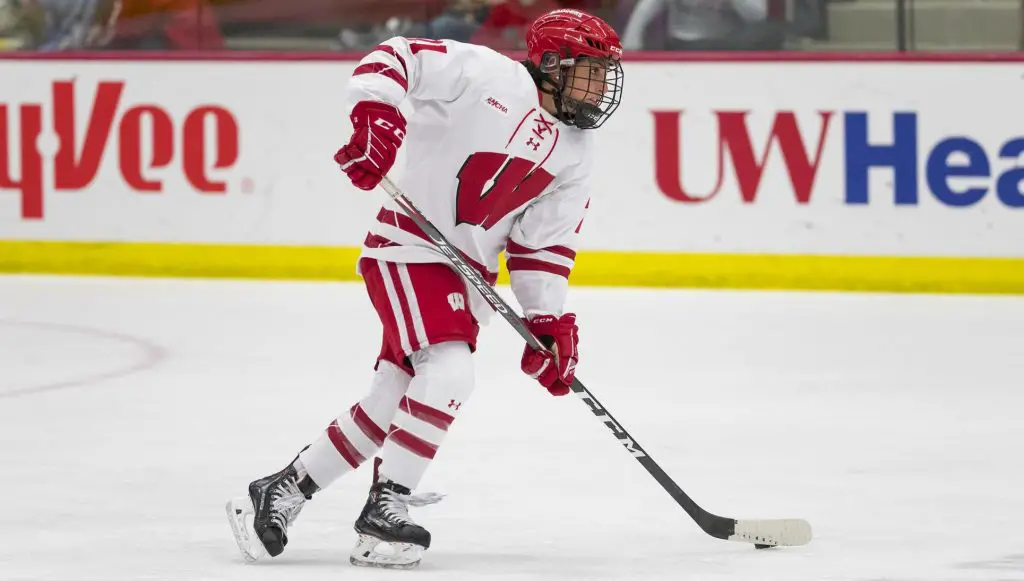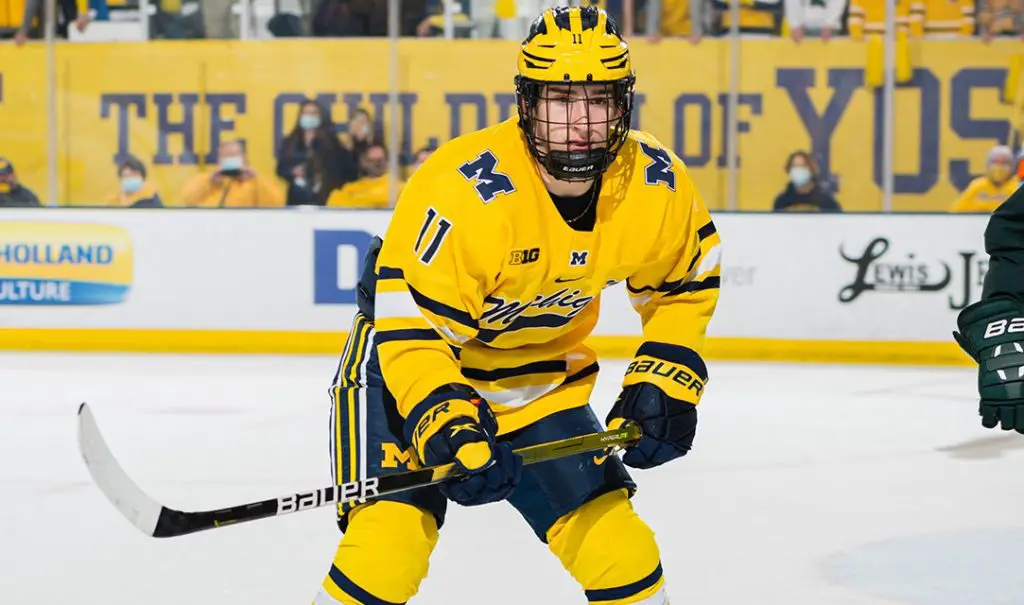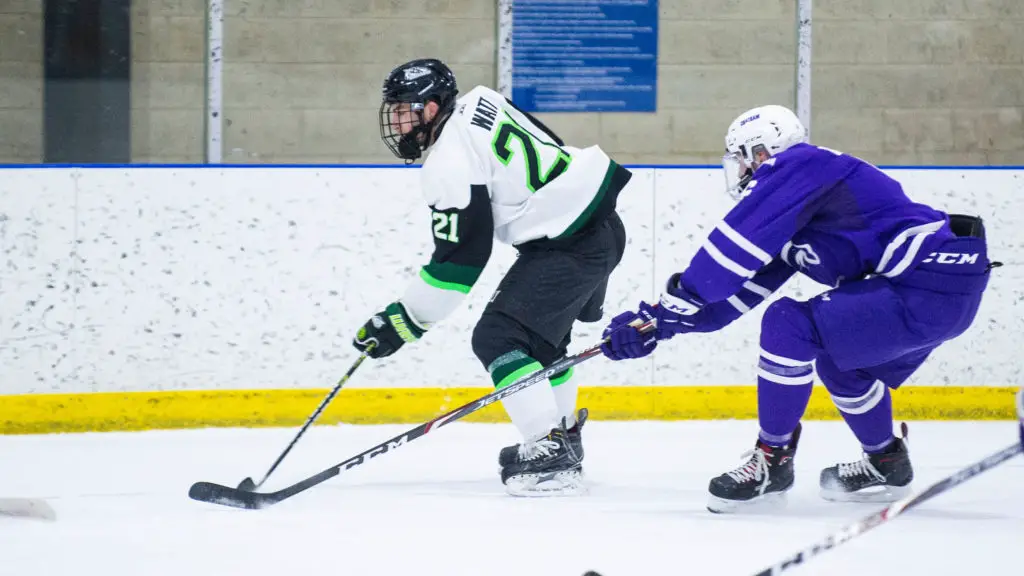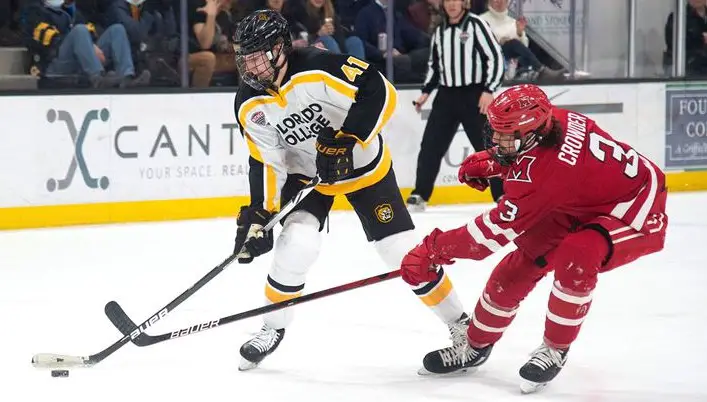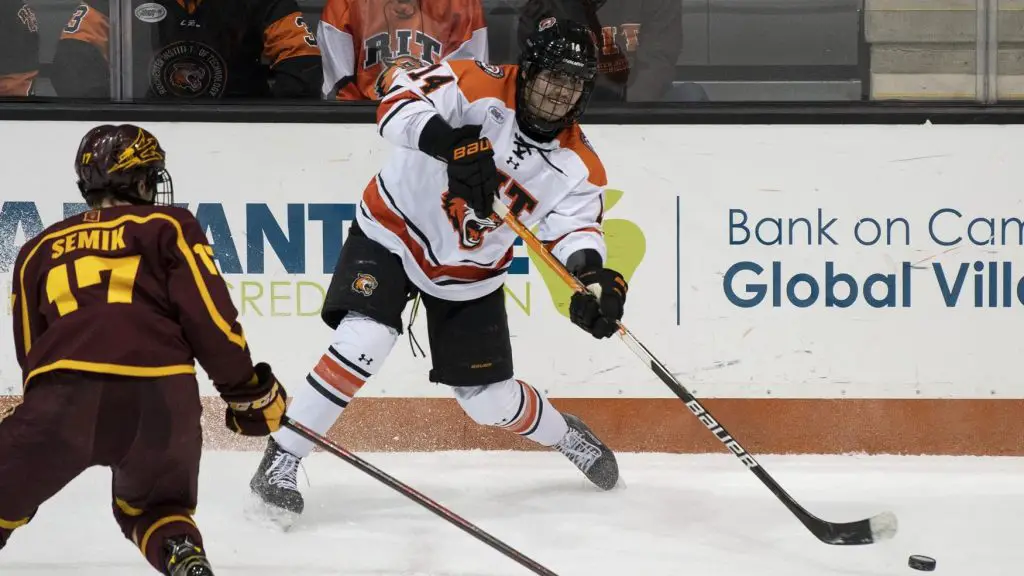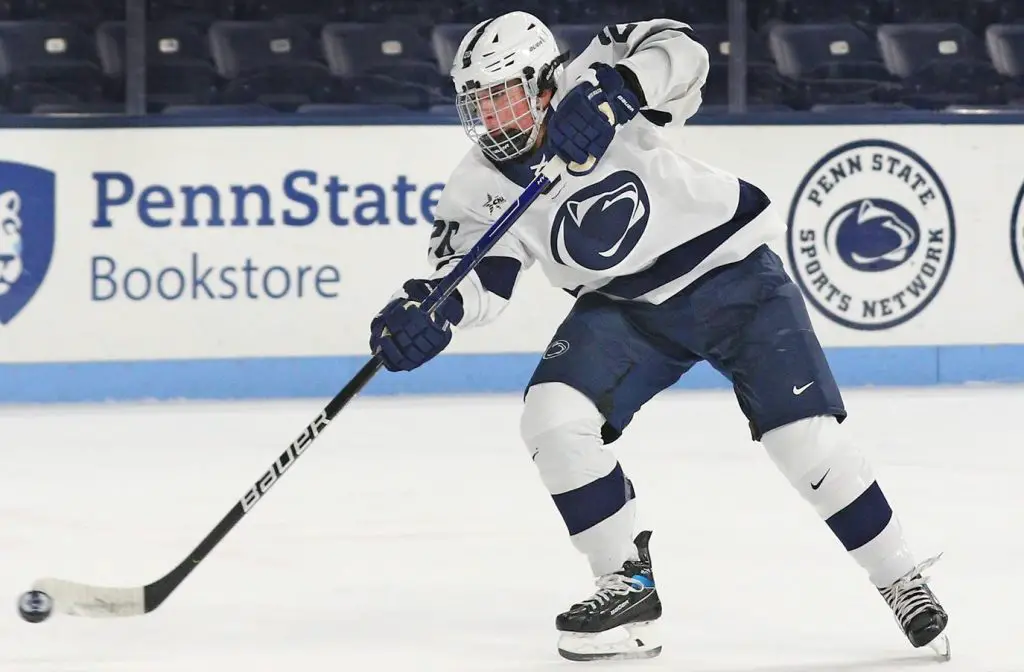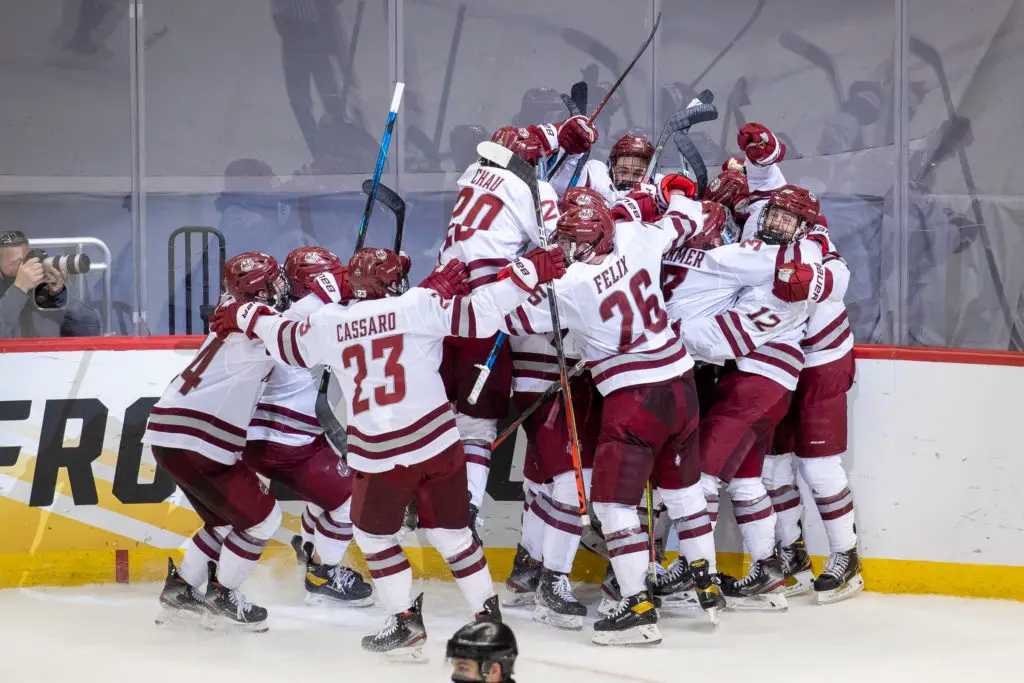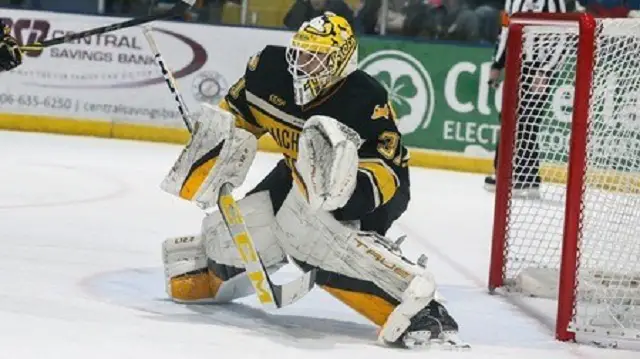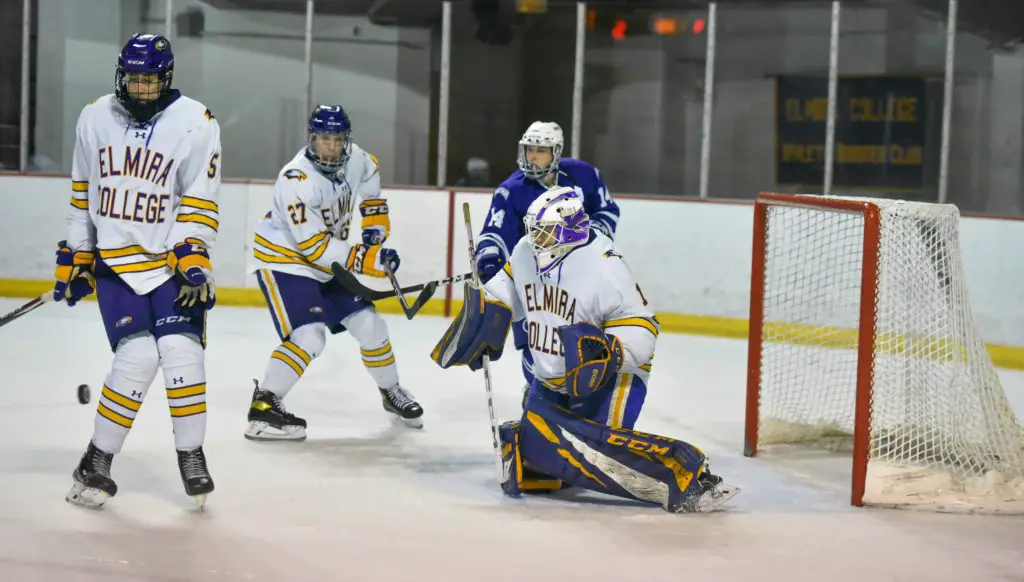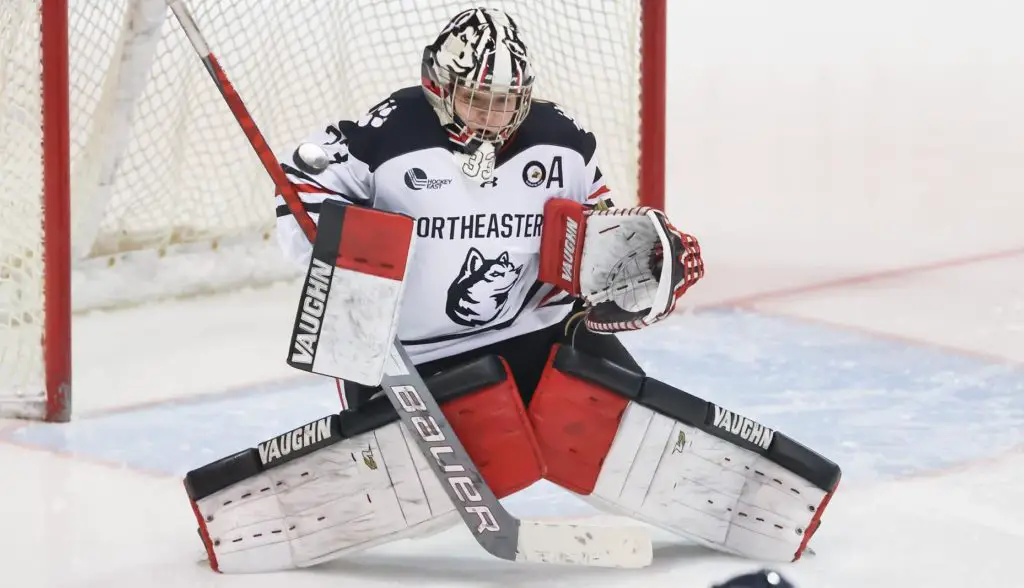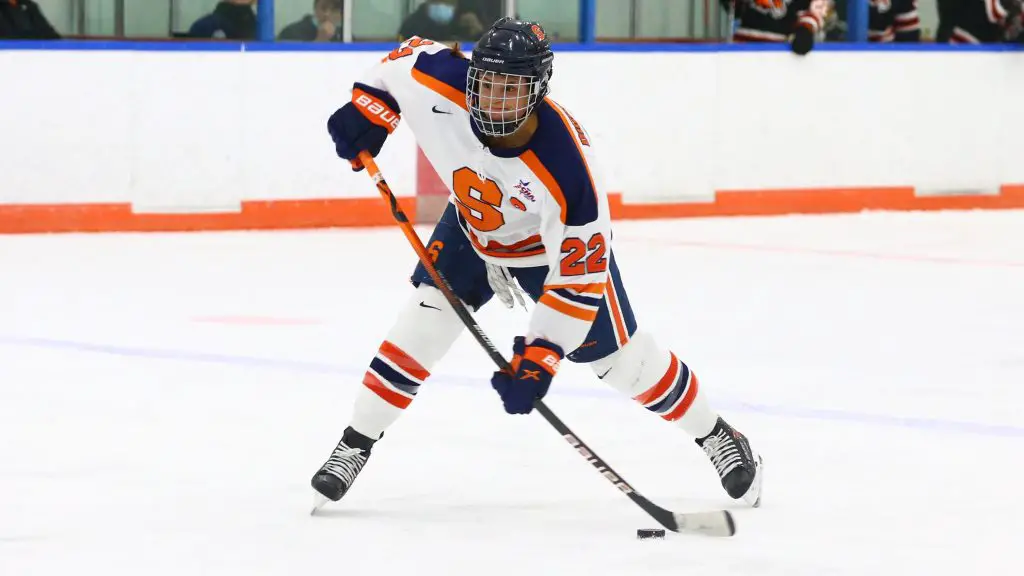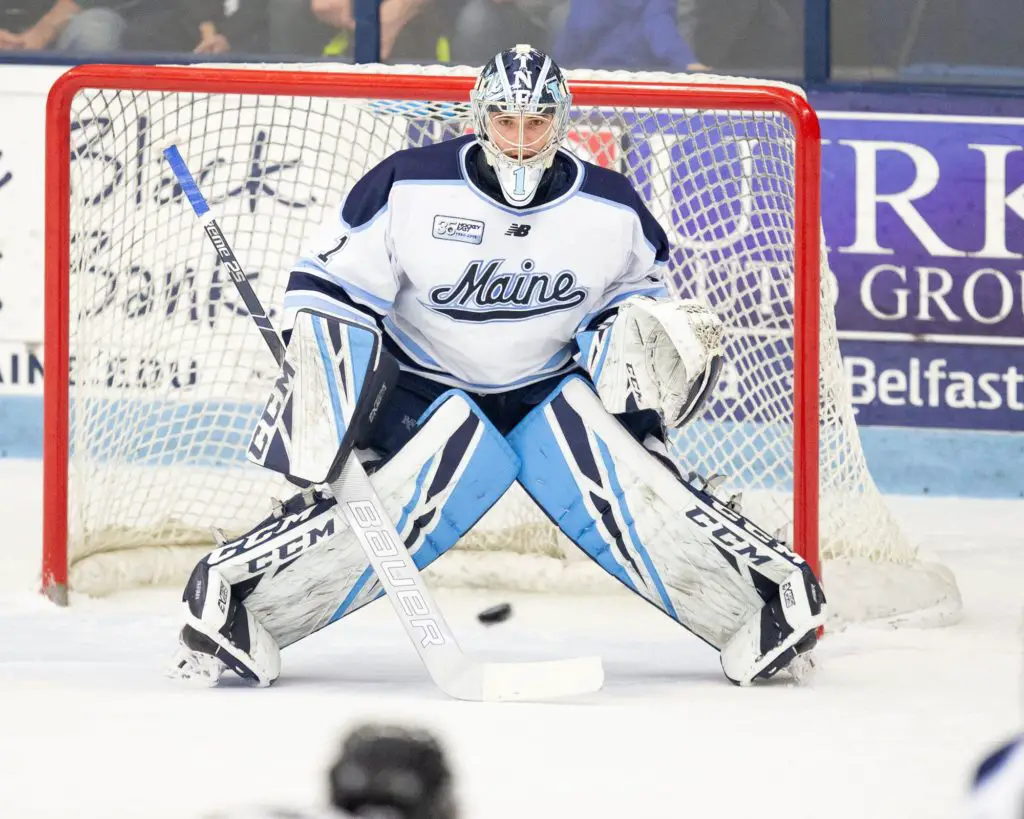(Editor’s note – This conversation will be published in two parts – check back on Thursday for the second half of this extra-long, extra-interesting Wednesday Women.)
Nicole: Happy postseason, women’s hockey friends! As we head into the first weekend of conference tournaments, we’ve asked a special guest to join the conversation this week. Grant Salzano writes about Boston College women’s hockey at BC Interruption and on Twitter at @Salzano14.
He also created his own Pairwise Predictor that allows users to plug in theoretical results of conference tournaments and see the results on the Pairwise rankings. It’s an incredible tool that Grant built from scratch that can drive you crazy thinking about what-ifs.
Before we work our way into possible scenarios for this season’s postseason, Grant, what are your thoughts on the changes to the NCAA postseason this year? We now have eleven teams instead of eight and that obnoxious travel reduction stipulation is no longer the law of the land. I was surprised the NCAA made the changes in-season, so let’s play a little what-if? How would the postseason conversation look different if we were still looking at an eight-team field?
Grant: Hello to you both, and thanks for having me! It’s a real privilege to be able to join you here; this is consistently one of the most in-depth women’s hockey columns out there and I really appreciate the insight that comes out of it and all the work you put into it.
It’s kind of funny; it seems like whenever a sport has a postseason expansion – MLB and NFL being the most recent cases – just anecdotally, it feels like the potential added excitement from having more teams on the bubble doesn’t materialize. Women’s hockey would have had an absolutely insane run to the finish this year if the tournament hadn’t expanded. Before expansion, the bubble would have been 7th place. The teams ranked 4th through 9th in the Pairwise – six teams – would be battling for at most three spots in the tournament where one loss would potentially be enough to drop you out of the field.
Instead, the bubble is 10th, and the gaping chasm from 9th to 10th is almost twice as big as the gap from 3rd to 9th. Sure, you’ve got your usual worries of a bracket-busting conference champion, and it’s not going to happen like this every year. But it’s funny that it worked out this way in year one.
Looking at the specific teams, it’s easy to see three WCHA teams in the top four (and maybe even four in the top four, which is not an outlandish possibility) and think “huzzah, we finally get to avoid these west vs. west quarterfinal matchups” now that the reduce-flights rule is gone… until you remember that there would never be any west vs. west matchups among teams in the top four anyway, since those teams were seeded. So there isn’t a huge difference there compared to what it would have been prior to the rule change.
To me, the most exciting change is the addition of this first round, especially this year when all those teams who will have to play in a first round game are ranked so closely. I’m expecting a lot of really fun, really close games (even if it’s an ECAC-fest) and definitely expect one or two of the lower-seeded teams to advance to the Icy Eight or whatever we want to call it now.
Nicole: Just interrupting to say I think we need to make Icy Eight a thing. Carry on.
Grant: Here’s a question that came up in one of my women’s hockey chats that I don’t really have an answer to: I finally got a chance to look at this year’s pre-champs manual and the seeding procedure is much more complicated than just 1 vs. 8/9, 2 vs. 7/10, 3 vs. 6/11, and 4 vs. 5 – the committee has gone the same way as men’s hockey with putting the teams in seeding “bands” and allowing for some movement within those bands to allow for eliminating non-conference matchups in the first round. That’s exciting!
But here’s the last step of the process:
“To complete each site, the committee assigns one team from each of the remaining seeded groups so there is a No. 1, No. 2, No. 3 at three of the sites using its priorities, while matching up the No. 4 and No. 5 overall seeds in a regional final matchup.”
There’s guidance in the criteria about setting up the Frozen Four so that 1 plays 4 and 2 plays 3 (bracket integrity), and there’s guidance on setting up the first round matchups too (avoid intra-conference matchups), but there doesn’t seem to be any guidance in there about exactly how they’re going to set up the *2nd* round matchups. Do we think they’ll maintain bracket integrity there (i.e. put the 8/9 with the 1, etc.)? Would we rather they continue to try to avoid non-conference matchups? What are we expecting/hoping for there?
I just worry we’re going to have something like…
1 Wisconsin vs. 8 Quinnipiac / 9 Colgate
2 Minnesota vs. 7 Harvard / 10 Clarkson
3 Northeastern vs. 6 Duluth / 11 Mercyhurst
4 Ohio State vs. 5 Yale
…and the committee will think “ope, we can save a whole lot of money by swapping the 7/10 and 6/11 pods.” Might they throw their heads back in a satanic belly-laugh and use it as an opportunity to (gasp!) reduce flights for the pods?
Nicole: Are Connecticut residents allowed to use “ope?” Be careful, Minnesota might not be so nice with you if you steal their vernacular and start implying the Gophers and/or Bulldogs are going to get screwed by the brackets (again).
Grant: I think legally we’re in the clear as long as we don’t say “Pop.”
Arlan: I’ve lived in Minnesota my whole life and grew up calling soda “pop,” but I’ve never used “ope” and don’t know what that’s supposed to be.
Grant: Vindicated!
Nicole: But seriously, if your scenario happens after we finally got that removed from the directives, we might have to revolt.
It’s interesting that some things are so clearly laid out and some are so ambiguous. I’ve been vocal about how ludicrous I find the choice to make it an 11 team field. It sure seems like even the NCAA doesn’t really know what to do with that nonsense number when it comes to planning out a tournament. It wouldn’t surprise me if we see tweaks to these rules after this year based on what the committee learns.
I’m not going to lie, I do love chaos. I’m happy the tournament extended, but I’m definitely a little sad we won’t have the fun of seeing who would pull out the final bids in a smaller tournament field. I do feel like things here in the final weekend are less tumultuous than they could be, but I have a feeling we’re going to see some upsets in conference tournaments that will make things more uncertain.
That being said, per Grant’s calculations, the difference in RPI from 1st place Minnesota to 10th place Clarkson is 0.04996. The difference between 3rd place Northeastern and 8th place Minnesota Duluth is 0.01773. The margins here are just so incredibly slim.
Arlan: Be careful what you wish for, or you may open the door to tumult that you have no desire to see. Watch some WCHA host get swept in the quarters, fall outside of the range of the old eight-team-tourney at-large bids, and just keep sliding out the bottom. The type of hypotheticals that Grant’s PairWise Predictor can bring to life.
My main objection with the brackets we’ve gotten over the years of the limit-flights directive aren’t so much with the competition or one opponent supposedly being tougher than another, but rather how stale the pairings quickly become. North Dakota’s NCAA experience over its history of making the tournament were trips to Minneapolis in back-to-back seasons for a sixth game versus the Gophers, a team that they’d played the weekend before. Quinnipiac reached the national tourney only in 2016; the Bobcats got a date with the Clarkson squad that they’d defeated six days earlier for the ECAC Championship and weren’t as fortunate in the reprise.
The avoidance of flights also contributed to repetitive matchups across conference boundaries, such as Mercyhurst traveling to Ithaca in back-to-back years to end Cornell’s season. Even when the purse strings were opened, selection seemed to be stuck in the same ruts. Princeton traveled to Minneapolis in its first three appearances; at least those took place over a period of years, so it wasn’t the same players having to make the same flight. In 2020, the Tigers finally earned a different quarterfinal opponent. Then Covid dropped on the sports world and the tournament didn’t happen.
As a fan, I hope for a more compelling tournament and storylines to accompany it than we often get.
Nicole: That’s a great point, Arlan. We can only hope this new setup gives us some new and interesting matchups than we’ve seen in the past. It’s always nice to see how different styles from different conferences play against each other and we really tended to lose out on that under the old rules.
Grant spent much of the time after he released his predictor fiddling with outcomes so he could find out how low Wisconsin could drop in the Pairwise, so those hypotheticals you mention aren’t so far out of the realm of possibility.
Grant, are there any sure things or fun quirks in this year’s math? What interesting matchups and scenarios have you found in your playing around with your calculations so far?
Grant: A couple interesting things that have come up that could affect the rankings are (1) the Duluth vs. Harvard comparison and (2) The Yale vs. Quinnipiac comparison. UMD swept Harvard in a series earlier this year in two games, and Quinnipiac is 3-0-0 against Yale. That means no matter what Harvard does and no matter what Yale does, neither team can win their Pairwise comparison against UMD and Quinnipiac, respectively. That’s not to say that Harvard can’t jump UMD *in the rankings*, or that Yale can’t jump QU – they can, but they’d have to pass an extra team in order to do so. As of right now it’s not affecting the as-they-stand rankings, but given that these teams are all in a virtual tie with each other, it definitely could happen.
The other thing is just that, wow, everyone is so, so close this year. It seems like nobody wants to be in first place. For a while the “Big Four” of Wisconsin, Minnesota, Ohio State, and Northeastern had some separation, but now here come the ECAC teams knocking on the door trying to get a home ice spot of their own because the top teams have faltered. And UMD is definitely in the ballpark as well. I’m not sure we’ve ever seen this much movement.
Arlan: The list of the top four, top 10, or whatever grouping we want to select is at the mercy of the ranking system that we’re using. The NCAA has blessed us with the PairWise Rankings, of which I’m about as big a fan as I am of the NCAA. The fact that it requires as many tweaks and adjustments as it does is a good indicator that it isn’t based on the soundest mathematical principles. The rules will be applied inconsistently or in the absence of forethought; an OT win is worth only two thirds of a win in the RPI, but what does it count in the Common Opponents or the Head-To-Head comparisons of the PairWise? Are these things even considered by the powers that be?
Grant: That’s one of the funny (“funny”) things about the new formula – OT wins count as full wins in the Common Opponent and Head-To-Head criteria. Do not ask me to figure out why. Given how much trouble I had programming this stuff into my calculator, maybe they just didn’t want to deal with the headache of the extra programming.
I’m only half kidding. Or maybe ¾ kidding.
Arlan: Anyway, you maintain three different ranking calculators on BC Interruption: the PairWise Rankings, the KRACH ranking, and your very own GRaNT rankings. There are places where these three ratings systems agree – they all have a bottom three of RIT, Post, and St. Michaels, in that order – but mostly they don’t. The good news is that they do reach a consensus on who the top 10 teams are, and they’re unanimous right now in slotting Clarkson as the last of those, the team that would be bumped from the field if an off-the-radar team beyond the CHA entrant secured an automatic bid.
There isn’t agreement on other key pieces, such as the top four seeds in line to host NCAA regionals. KRACH has the NCAA nightmare scenario of the top four WCHA teams as the top four seeds, with Ohio State leading the way. GRaNT also has the Buckeyes on top, but slots Wisconsin second and Minnesota third, a reversal of KRACH, and completes its top four seeds with Northeastern rather than UMD.
None of this matters, as the NCAA uses the PairWise. Its top four in order are Minnesota, OSU, Northeastern, and Yale. Yale is currently a rather distant No. 8 in KRACH. Though I dream of a day when the NCAA selects a better ranking system, the Bulldogs from New Haven are safe, as I’m sure that the NCAA will still be endorsing some RPI based system on my dying day.
As juicy as the hypothetical case posed by Grant (the columnist, not the ranking system) may be, what looms on the actual horizon is fraught with as much uncertainty. PairWise could still pivot in an unexpected direction and produce unimagined brackets, given how close these teams are.
Grant: A by-product of all these teams being close in the rankings means that the tournaments are going to be close, too. There are nine (!) likely NCAA tournament teams between the WCHA and the ECAC. I mean, honestly, do you have any confidence in trying to pick who is going to win the WCHA between Ohio State, Minnesota, Wisconsin, and Duluth? Can you even begin to guess who is going to come out of the ECAC tournament unscathed among Yale, Harvard, Quinnipiac, Colgate, and Clarkson? h
Really, the teams are so close that if you used KRACH as a ranking system, Yale would be out of the tournament field under the old format (8th, knocked out by the CHA champion), but with the Pairwise they are currently sitting at 4th, with home ice for the quarterfinals! What?!
Arlan: For many years, the WCHA Championship was won by the No. 1 or No. 2 seed; that was it. Low-ranked teams might pull an upset in the quarterfinals, or a team seeded fourth or fifth might make a surprise foray into the final. That type of result started with Ohio State in 2001, and the most noteworthy example was likely Bemidji State in 2015. Both of those teams dumped a top-seeded Minnesota team in the semifinals, so you have a valid point that the Gophers shouldn’t read too much into a high seed.
In a twist, Minnesota was also the first third-seeded team to win the WCHA tourney, that coming in 2018, and the Buckeyes duplicated that feat in 2020. Prior to that, it seemed that the energy needed to pull off a semifinal upset left that team unable to spring another surprise the next day. Much of that was due to the top seeds simply being visibly better than those further down the standings, and the odds didn’t favor back-to-back upsets.
Can UMD be the first team to hoist the WCHA trophy when seeded fourth or below? The Bulldogs have definitely shown that they can hang with anyone in the field, having a pair of wins over both OSU and UM, and a win and an overtime loss versus Wisconsin. Where UMD has been lacking is defeating a ranked team twice in a weekend. At least it couldn’t manage it in league play, but it did take Harvard down on consecutive days.
The other teams have question marks as well. Wisconsin dipped in December and hasn’t been able to regain its previous level. Minnesota’s likely starting goaltender has had a couple starts where she’s given up a soft goal early, putting her team in the kind of hole that can end a tournament run. Much has been said about OSU’s last-second loss in Bemidji with their goaltender pulled, but the bigger issue is being tied in the closing seconds of a must-have game. One can choose to look at the fact that the Beavers plagued Clarkson and Wisconsin similarly early in the season either as evidence that BSU can do that to anyone or a warning that the Buckeyes should have heeded.
As for the ECAC, the top of that league looks like it is in transition, but far be it from me to say in what direction teams are headed. It went into the last couple of weeks with teams having a wide range of where they were likely to finish, which would suggest that the playoffs will be wide-open as well. The one thing that didn’t have drama was which teams would be included in the eight-team field. The best eight teams have advanced, so I hope that the tournament lives up to its promise. Having Harvard sitting atop the conference isn’t quite the intimidating presence it was when the Crimson were a national contender on a yearly basis, so I agree that the ECAC is as wide open as it’s ever been.
Nicole: As much as we’ve focused on the WCHA and ECAC, Hockey East has traditionally been the tournament primed for surprises and upsets. It feels like this conference can be the most volatile in terms of surprising outcomes, especially in one-and-done games. Northeastern is by far the favorite, but who else do you think has a legitimate chance to win the tournament? Who’s the dark horse that you think could go on a couple-game run and surprise everyone?
Grant: You mentioned to me offline about Hockey East seeming by far the most likely to produce an upset champion, if only because the WCHA and ECAC all have so many teams at the top that any of them winning wouldn’t really be an upset. That’s a great point and really does make Hockey East the most likely league for an upset just by default – *anyone* winning the league other than the Huskies would qualify as a pretty sizable upset.
If we quantify an “upset” as an automatic bid from outside the top 10, then Hockey East is really left as the only option since the CHA is going to get it’s one tournament spot no matter who wins. But it actually gets better – Hockey East moved to a single-elimination tournament this year, so if you thought it was prone to upsets before, you’d better buckle up. The teams in the top six just have to win three games to win the league title.
As for which team is the most likely – Northeastern gets Alina Müller back in time for the postseason (I am pretty sure she returned stateside this weekend, so she should be) that really narrows down the possibilities, for me. There seems to be a pretty stark drop after the top four of Northeastern, Vermont, UConn, and Boston College, and I really don’t see any way a team like BU, Maine, Providence, or UNH are going to both take down Northeastern and also win 3 games on the road to be bracket busters, especially when some of those teams (looking at you, Providence) look like they can’t wait for the season to end.
But among teams in 2nd through 4th, I could see it happening. I don’t think it’s likely – I think pretty highly of Northeastern when they’re at full strength – but it’s single elimination, and Vermont in particular is on fire lately.
Arlan: Northeastern is a key team in the bracket moving forward. They were a kind bounce away from being Hockey East’s first NCAA Champion last March. While BC and BU have also reached the final, twice in the case of the Terriers, neither was able to extend the drama beyond the final buzzer.
One way to look at the Huskies is to say that in 2021 they knocked on the door, and now they’re in a position to kick it in. The Wisconsin team that denied Northeastern its dream ending doesn’t look to be playing at the same level of late, with a roster depleted both by Olympic centralization and key injuries. The Huskies have had leading scorer Maureen Murphy in the lineup for a full season, and one would think that she’s better integrated into what they’re trying to accomplish. Northeastern hasn’t lost while at full strength, as all of their defeats have occurred while Mueller has been out, and as you’ve indicated, the Huskies figure to have her the rest of the way.
Yet, history hints at a couple of worrisome trends. Players who compete at the Olympics typically don’t make a seamless return to NCAA competition, at least immediately. UMD in 2002 relied heavily upon European Olympians. When they returned to Duluth after the Salt Lake Olympics, it took the Bulldogs several weeks to start playing like a championship team once more. The Noora Räty who returned from the Vancouver Olympics in 2010 was a shadow of what she had shown before her departure.
Müller was such a big part of Team Switzerland. She looked to empty the tank down the stretch, playing 23 minutes in an emotional win over the Russians by another name, followed by a physically-taxing effort against Canada in the semifinals, and almost 26 minutes on ice in the bronze-medal game. Beyond the physical effort of the competition and the travel, the near miss must have exacted an emotional toll.
Plus, they face the same question that has been asked of New Hampshire, BU, BC, and past contending Northeastern teams, “Has the Hockey East campaign challenged them sufficiently to prepare them for what awaits?” As you said, none of the HEA competitors are found in the top 10 of the PairWise. In crafting the schedule, Dave Flint and his braintrust could have expected a test from Princeton and Cornell, but neither of those programs broke into the upper echelon either.
You have a better perspective on the Huskies than I do. Are they positioned to push beyond these and other challenges?
Grant: I’m of two minds with Northeastern. On the one hand, they really are a completely different team at full strength. It’s not just the addition of Müller back into the lineup, it’s that the whole line chart gets put back into position. They were also without Chloe Aurard for a few games prior to this past weekend, so that’s a double-shot of espresso for them.
On the other hand, watching the WCHA teams at the top knock each other down week after week has been demoralizing as a fan who really wants to see Northeastern take the trophy (as long as my Eagles don’t, of course). The WCHA does not have the feel to me of a conference that is having its imperfections exposed. It does feel like a conference with four gladiators who are only making each other stronger while they try to kill each other.
If there was ever a year to test the theory of “is a soft schedule or an absolute nuclear gauntlet of a schedule better to prepare you for the postseason,” it’s this one. I have never seen Hockey East as weak as it’s been this year, and I have never seen the WCHA as strong as it’s been this year. Maybe the Huskies will be less beaten down. But my experiences watching BC not be able to break through a handful of years ago give too much painful evidence to the contrary.
Nicole: I suppose I do assume Northeastern will win, but I definitely think they’re more vulnerable than we would have assumed earlier this year, particularly in the single-game format. I also worry for any team whose fortunes hinge so much on one player. As Arlan mentioned, the post-Olympic lull is real and the timing means there’s no easing into things, particularly in Hockey East. On the other hand, it’s not just how good Müller is or isn’t, it’s about the whole team getting to play where they’re most comfortable, which would put them in the best position to pick up any slack and make their best possible contributions.
That being said, I would not bet against Vermont or Connecticut in any one-game scenario right now. I mean, I wouldn’t bet against Northeastern, either. I’m saying I think those games could very easily go either way and the winners are all of us that get to watch, but who have no stake in who wins.
… to be continued
